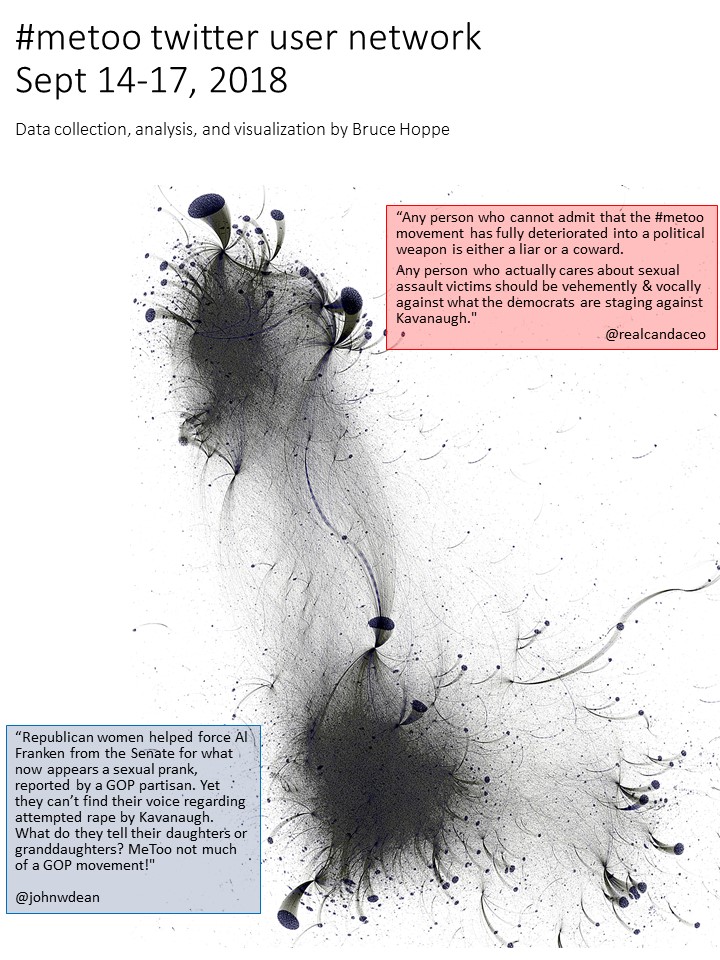I just finished collecting one week of #metoo tweets, coincidentally starting just before the explosion of Kavanaugh SCOTUS controversy. Believe it or not, I thought I had picked a relatively quiet time when nothing in particular was rocking the #metoo conversation. Wrong! A few days and half a million tweets later, here is my preliminary result. A network map showing how people are connecting with each other over #metoo.

The striking feature of the network is, of course, how dramatically it is split into two sides. I analyzed the retweeting separately for each side of the network, and displayed the most-retweeted message from each side in the picture. Behold, the distressingly familiar red-blue divide.
I have just started analyzing and making meaning of the data. I am curious what questions you think are worth asking. Some questions on my mind are:
- Is the “baseline” #metoo conversation that I was looking for in here somewhere?
- Who are the bridgers that connect across the big divide? What are they saying?
- What else is going on here besides red vs blue? In particular the bottom/blue portion appears to have multiple factions.
Also, what does this mean for #metoo? How will the good non-partisan intentions of the movement survive the ripping forces of polarized American politics?
Let me know what you think and I look forward to doing more with this data.
Thank you so much for this. I’m fascinated. Any data on how this breaks down male vs. female? Would you guess that it’s equally polarized?
I see a significant set of bridgers across the red/blue divide as you map them. What’s–roughly speaking–the content of their tweets? What can we learn from the generalized content of their tweets that we might use to bridge that gap? Are those helpful conversation starters? For example, is it less about politics or gender than about power (which, we might be able to argue, has some kind of impact on everyone in some way?)
Seems as well like each “side” has some pretty powerful outliers. What can we learn about them? Is an analysis of their tweets worth something? Can we understand something more from specifically working to understand their frame of reference (i.e. listening more carefully to their stories? Are they influencers, and how?
Looking forward to learning more!
Thanks, Sara! Great questions.
It turns out that Twitter does not provide a “gender” field in the user profile, but I recently saw an answer to your question at https://fivethirtyeight.com/features/the-biggest-divides-on-the-kavanaugh-allegations-are-by-party-not-gender/
I will look into the key players you ask about, and the text of the tweets, and post an update soon.
Bruce,
Thanks for doing this map and sharing the results and invite for feedback. Like Sara, I am really curious about what are the differences that make a difference in terms of the clusters. Are there some differences that are easier to influence? As a natural bridger, i would also like to know much more about the nodes in those positions.
Very grateful for the visual and intrigued by the ability to map “tweets”. I have read other articles you worked on and am grateful for your contributions to the world. Thank you.
Hi Kristin, good questions. I just posted a follow-up that looks much more carefully at the differences between the left and right clusters. See http://connectiveassociates.com/2018/10/conversations-in-networks/
I am curious what you’re getting at when you want to identify differences that are *easier to influence*. Is that about strengthening the bridges? (I still don’t know who are the bridges by the way, but that’s on my to-do list.)
I hope you enjoy the follow-up link I shared and I’d love to hear more.